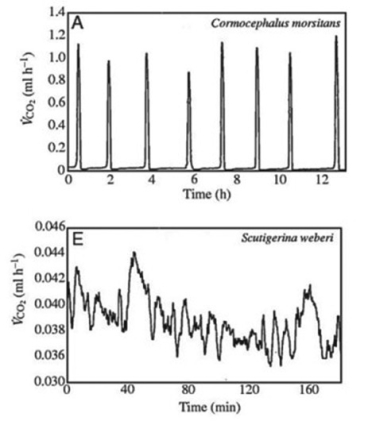Multiple Choice
Use the following information and figures to answer the question.
Many terrestrial arthropods exchange gases with their environments by using tracheae, tubes that lead from openings (called spiracles) in the animal's exoskeleton or cuticle directly to the animal's tissues. Some arthropods can control whether their spiracles are opened or closed; opening the spiracles allows the carbon dioxide produced in the tissues to travel down the tracheae and be released outside the animal. Klok et al. measured the carbon dioxide emitted over time (represented by ⱽCO₂) by several species of centipedes. The figures present graphs of their results for two species, Cormocephalus morsitans and Scutigerina weberi.
Look at the graph for Scutigerina weberi (note the scale of the y-axis) in the figure. What is the best interpretation of these results?
A) The centipede had its spiracles open the entire time.
B) The centipede had its spiracles closed the entire time.
C) The centipede had its spiracles open when carbon dioxide (CO₂) emission peaked and closed when CO₂ emission was low.
D) The centipede had its spiracles closed when carbon dioxide (CO₂) emission peaked and open when CO₂ emission was low.
Correct Answer:

Verified
Correct Answer:
Verified
Q7: Which of the following is most likely
Q11: Molecular studies have changed many of the
Q21: All insects _.<br>A) undergo complete metamorphosis and
Q33: Which of the following animal groups is
Q41: Healthy corals are brightly colored because they
Q42: Use the following information and figure to
Q44: Use the information and figure to answer
Q45: Use the information and figure to answer
Q50: Which of the following statements is correct
Q66: The presence of a lophophore in a